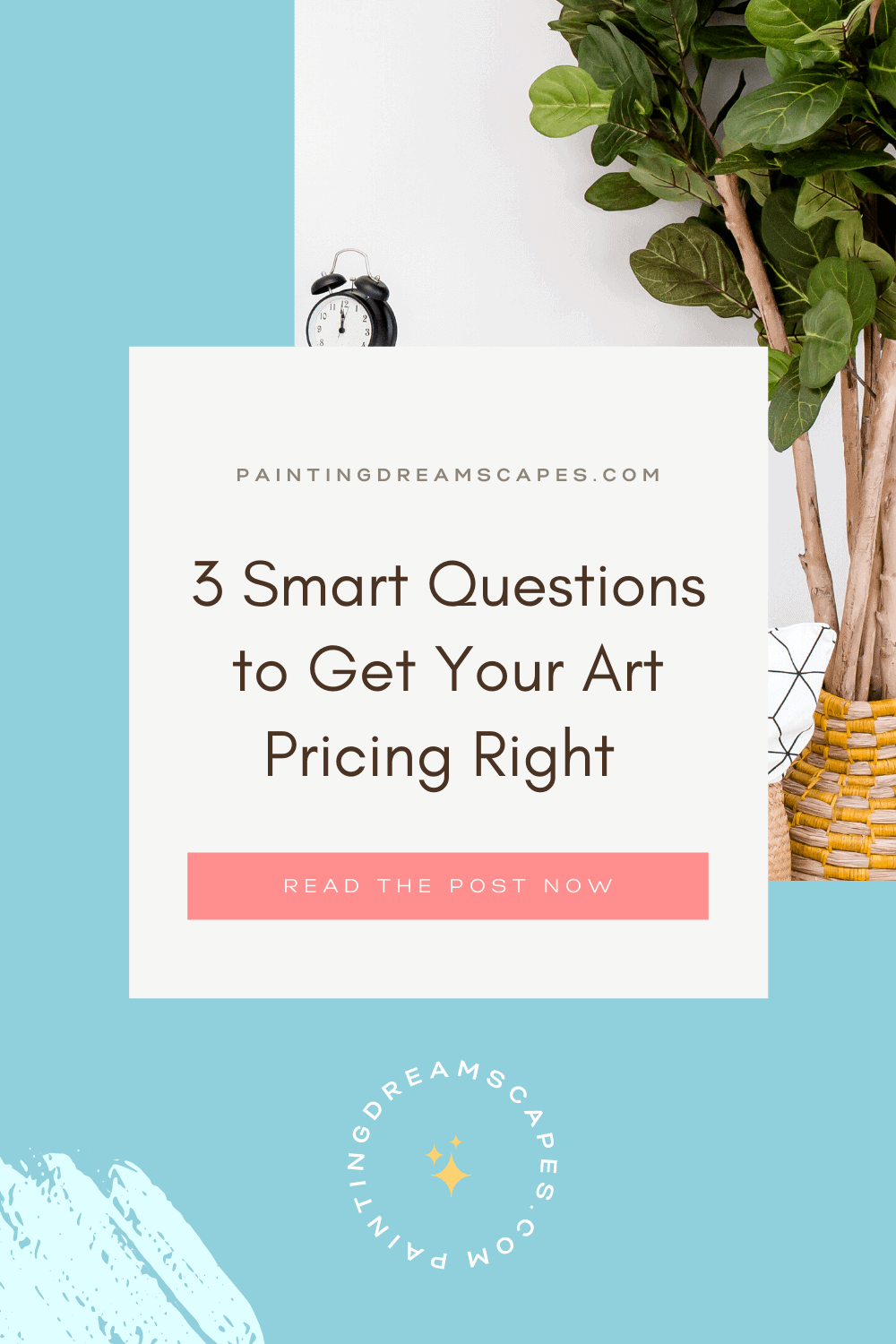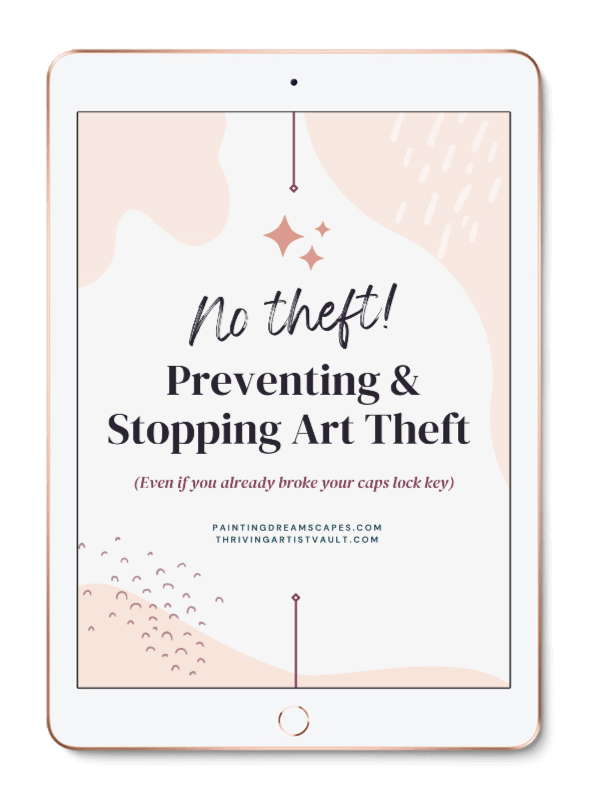Have you ever talked to someone who wanted to commission you and the moment you shared your art pricing with them you felt a sting of fear surging inside? The sudden feeling of inadequacy, like you’re so not worth your prices? Like maybe you should offer that client a juicy discount so they won’t leave empty handed... Or mock you for expecting to be paid fairly for your work?
Now, if you’ve ever second-guessed your commission prices, I hear you. I’ve been there and I undercharged for my art for many years. I’m here to help you learn how to come up with an art pricing structure you feel 100% confident in and that’ll help you reach your income goals without overworking yourself.
Because when you stand by your prices without second-guessing yourself, you’re able to show up and sell with confidence. That's what I want for you.
In this post you’ll learn the three questions you can ask yourself to get on the fast track to making a stable income from your art by nailing your art pricing (without working your buns off in the process).

Question #1: How much money do you want to make from your art?
Ohh big question right there! I can imagine the answer is “A LOT!!” but let’s get a lil’ bit more specific, shall we?
It’s okay if you want to generate a lot of money from your art (and it’s also doable). But you want to be super specific about how much money you want to make from your art.
Or else you won’t be able to hit your income goals. Like the saying goes “If you don’t know where you’re going, you’ll end up someplace else”.
Some figures to get you started: how much money do you need to make to cover your living expenses each month? It’s a great milestone to be able to pay all of your bills with the money you make from your art.
Once you’ve covered your basic living expenses and you’re ready for the next goal, think. How much money would you need to make from your art to be able to live comfortably?
> Related:
Is being an artist such a risky career? Expectations vs Reality
Your revenue goals will determine the next steps to pricing your art. Be intentional about selecting them to choose a pricing strategy you feel confident in.
Question #2: How many commissions can you work on each month?
Has your mother ever told you “You eat more with your eyes than with your mouth?”.
Such a classic!
It basically means that you want to eat more than your stomach can handle. So you hoard all of the goodies but then you’re so full you could just explode right there.
The same happens with your art. Let’s be honest. When you read the question, did your brain immediately picture yourself being incredibly productive and getting all of the commissions done in no time and with barely any effort?
Weeeell, you’re not alone. But you’re in for a bad time if you indulge that belief.
Pricing your digital art right is no easy feat, but if you want to hit your revenue goals you need to be realistic about your workload limits. Unless you want to start getting stressed and stop enjoying your art career...
The last thing you need is to agree to more commissions than you can realistically complete. Having a lot of angry clients on your back complaining + requesting refunds isn't fun.
Let me ask you again, how many commissions can you reasonably work on and complete within a month?
Keep that number in mind as it will be key to pricing your art without second-guessing your choices.
Want even more help pricing your art and coming up with your commission offers? Download my FREE Pricing Your Art Decision Making Workbook! 👇

Question #3: Are your current art prices reflecting these factors?
Alright friend! This is it, this is where you get to run the numbers to see what you should be pricing your art to hit your revenue goals without overworking yourself.
You’re going to divide your revenue goal by the number of commissions you can take each month. The resulting number is the *minimum* you should sell your commissions for to reach your revenue goals and make a living from your art.
I recommend that you do this twice. Once with the sum of your living expenses and again using your ideal income.
The former will give you the pricing structure you need to *at the very least* cover your living expenses. On the other hand, the later will give you more freedom and control over your pricing and play with higher fees for your art.
Use this formula:
[REVENUE GOAL] ÷ [# OF COMMISSIONS YOU CAN TAKE] = [YOUR BASE PRICE]
If you’re already selling commissions, how does your current art pricing structure compare to the pricing you should offer to meet your income goals?
Are your current prices exactly right and keeping you on the right track to making a stable income from your art?
> Related: Why pricing your art too low will keep you poor (and how to avoid it)
If you’re pricing your art too low out of fear that people won’t commission you, you may never reach your income goals without overworking yourself, or at all.
If you want to make $1000 per month but you’re selling each commission for $20 you’d need to sell 50 commissions to hit your goal. And maybe that’s doable for you.
But what if it’s not? If you can only work on 20 pieces per month or fewer, at $20 the piece, you’ll never achieve your income goals.
So… Make sure you run the numbers to ensure you’re on the right track 😉
Want to find your pricing without wasting time doing the math or using other methods like pricing based on hourly rates?
My brand new art pricing calculator will help you do just that! It comes with four different pricing calculators you can use to determine your pricing and it comes with monthly and quarterly income trackers to make it easy + fun to keep track of your revenue & hit your goals.
Plus, the income stream accelerator will help you stop trading time for money and start making passive income instead!
Over to you - Are you feeling more confident about your art pricing?
After reading this post, you know the three questions you need to ask yourself to confirm you’re pricing your art correctly so that you can make a stable income from your art without overworking yourself.
If you implemented the strategies I shared, you should feel confident you absolutely nailed your pricing for your art commissions and you’re ready to work with clients and hit your revenue goals.
You may still be tempted to price your art low to attract more clients or protect yourself from mean clients who want to demean you for knowing your worth.
But I know you’ve got it in you to charge what you’re worth (and then add tax) and that you’d rather work with fewer but dreamier clients, than with countless nightmare clients who don't value you or your art.
You’ve got this. You’re on your way to becoming a thriving artist who ALWAYS hits their income goals and then some.
Ready to learn even more about pricing your art and getting started with selling your art? Download my FREE Pricing Your Art Decision Making Workbook! 👇

I want to hear from you







0 comments